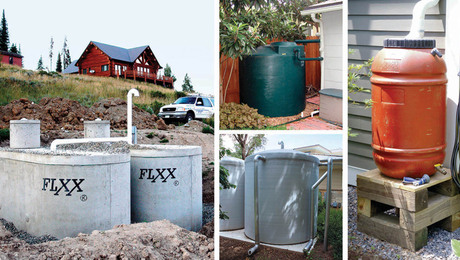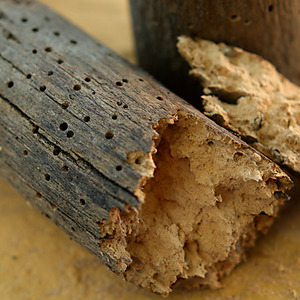In Florida, mold is eager to form on paper drywall. I am thinking of replacing the 50 year old walls in a bathroom with rockboard. The rockboard would be finished with a skim coat of plaster instead of the usual tile. I get the luster of plaster walls and a moisture resistant wall material. The blue colored drywall that is used for plaster is unknown here and when they tell me to just nail up regular drywall and slather it with drywall mud, I cringe inside while thanking them for their assistance. Is it possible to create a durable wall out of rock board skimmed with plaster?
Discussion Forum
Discussion Forum
Up Next
Video Shorts
Featured Story

There's a constant source of clean water for you to use, and all you have to do is collect it.
Featured Video
How to Install Exterior Window TrimHighlights
"I have learned so much thanks to the searchable articles on the FHB website. I can confidently say that I expect to be a life-long subscriber." - M.K.

















Replies
"when they tell me to just nail up regular drywall and slather it with drywall mud,"
That sort of language belongs over in Cooks Talk.
Blue board is a special order item in my locale as well. I plaster over regular drywall and use a bonding agent.
Your idea sounds plausible to me but you might want to check with the tile backer (rockboard?) mfgr.
Edited 11/26/2006 1:02 am ET by McFish
What are you calling "rock board". Are you talking about rock lathe. That takes two coat plaster.
And if you did have blue board you will still have the paper would the mold could feed on.
I think that what you would want is one of the paperless drywalls. Nonething for mold food.
Thanks for your note. I was thinking of the cement board that is used to back tile. I have tried the paperless drywall ( denshield ) and it is not bad but the manufacturer doesn't know if it has sufficient "tooth" to take a skim coat of plaster. Also it is fragile and difficult to use alone
maybe...which rock board are you thinking of using.. please be specific..
if you want a plaster / dryline finished wall look for a product called rock lath or plaster board and not rock board...
do you currently have a mold issue???
so lets got this puppy cranked up and out the door..
Life is not a journey to the grave with the intention of arriving safely in a pretty and well preserved body, but rather to skid in broadside, thoroughly used up, totally worn out, and loudly proclaiming
WOW!!! What a Ride!
Forget the primal scream, just ROAR!!!
No reason why you cant do a white skim of real plaster, (veneer plaster) over Dur rock board the cement board you use for baths. I've done it and it holds up fine. tae all seams and corners with fiberglass mesh tape.
I have also used durock with plaster over it because my upstairs neighbor overflowed the tub more than once. It held up fine and has been in place for 7 years.
I've used Durock on walls before. If you are worried about moisture you want to be careful about the coating and tape. Don't use paper tape, which mold will eat. Use fiberglash mesh in this application -- Durock sells an alkali resistant tape for use with its cement board. Also use setting type wall compounds, not regular drywall mud.
Billy
Thank you all for the ideas. I'm psyched to be able to use plaster. The current walls are plaster on top of some cementatious layer and I have repaired the ceiling with wire lathe, structo-light, and then veneer plaster. Soon though I must replace the ceiling. It is fifty years old, is above a shower and has held up that long without a vent fan in the ceiling.
That 'cementatious layer' you talk about may very well be portland if it's in the bath. Pray that it isn't because the demo of portland on wire mesh is a b!tch. Any way you look at it it's gonna be a mess, but you're doing the right thing.
It's Portland all over the place. The amount of dust that it kicks up to disturb it is incredible. And there's wire mesh at all corners and edges. I have to use a grinder to cut it while it spits hot sparks at me, or I have to grind the cement with a masonry blade so that I can cut the wire mesh with tin snips.This is a spec house from 1956 in Florida. The 2x6 ceiling on 16" o.c is sagged a little from the weight of it.
My experience with this is very limited. Sounds like "standard" gypsun lathe plaster.The bases is a narrow gypsun board with hole. Metal lathe is used in the corners for "tape". Then it is coated with 3/8" sand mix like. then topped with 1/8" plaster.
That is almost exactly what it is. There are no holes in the gypsum board but otherwise you've got it. The gypsum is in pieces that are two feet wide and eight feet long nailed across the 2x6's in the ceiling or to old treated strips of wood on the cinderblock. It is really think where plumbing fixtures pass through it. Routing wires behind it is tough. On the walls I fear that putting up drywall to replace this invites the formation of mold in between the drywall and the cinder block. In damp areas I would like to use cement backer board with a skim coat of plaster
Usually a masonry blade will go right trough the mesh. Wear a resperator type mask.
Thanks. I always wear a respirator because the amount of dust that flys when you cut it with a sawz-all or masonry blade is too much. Sometimes the masonry blade gets stuck in the mesh as it is older steel mesh
Jer, I've got a similar house - cinderblock and gypsom lathe. I've been doing some cutting of gypsum lathe walls in my home recently. I've been using a dust mask that comes with two yellow elastic bands to hold it on my face.(Maybe 3-M) Are you saying that I should be wearing something more protective? A respirator? I was wondering whether this plaster could have asbestos in it?
Google Denshield...or go to Georgia-Pacifics website
I'm shocked no-one else has mentioned it yet
Durock instead of sheetrock sounds like a bad idea to me....
"Durock instead of sheetrock sounds like a bad idea to me..."Why would that be?
Way too much work....heavy, dusty, needs full skimming after it's up, expensiveI know Denshield is available in Florida...I've used it thereand anyway, mold is everywhere-the key to controlling it is controlling moisture....not building a totally concrete & steel building
I've used Denshield many times and you say it's less expensive? Maybe it is now, it's been about 6 months since I've done a bath. Given the choice I would probably use the Den because it is cleaner, but I don't think it would require that much less work as far as the plastering goes.
Even if the Dens is comparable in initial cost to Durock, the ease of instal still tips the scale for me....and I'm not sure why the OP was planning on skimming instead of tile, but I think it's because even if he did a wainscote tile wall on the proposed Durock, he'd still have to skim the top half to get it to look right.
Me, I like true mud jobs with true sanitary cove & then up the wall with tile, but who can afford that anymore...
Yeah, I don't know many who do the true mud jobs anymore. That's how I learned to tile way back when. Leveling a way out of wack floor is the beauty of it.
So right....I've done full mud floors, but even then they weren't exactly the old-time way, where the tile went on in the wet mud...and I really don't know how they got that thick layer on the wall, and the tile laid wet in it....guess mud was a lot different back then....it's as much a lost art as pebble dash stucco-
Two ways of doing a mud wall. You could either butter the back of the tile and apply it to an already set screeded wall, and tamp it in place, or you could apply a loose coat of mud to a scratch coat that's been dampened and tamp the tile on.With a floor, you lay in your mud on top of diamond nailed down diamond mesh and felt and screed it level...it should be like a wet sand consistancy that forms a ball in your hand when squeezed, very little wetness. Once that's down I take dry portland and a little sand mix and powder the top of the area that I want tiled, then I spritz it well with water and set my tile. I used to spatter it with my plastering brush, but I found the spritzer bottles to be more even. Or...you could screed your floor with just portland and sand and then butter the back of your tile with a looser mix of portland-lime and sand (masons mix), and set the tile. This works well with the bigger tiles.I don't do them much anymore. I usually nail and glue down dens or durock and use thinset.
Another option used commercially in wet areas is FRP: Fiberglass reinforced plastic, but it is not something you would coat with plaster.
I used to live in Massachusetts where blueboard and skim-coat plaster were common. I agree with you, the finish is much nicer than the texture of a sheetrock wall where you can see every seem in the right light. Too bad where I am now it's not as common. Skim coating with joint compound is NOT the same thing.
I agree with the posters who said that eliminating mold food is the way to deal with mold. If you're having trouble, you don't have adequately conditioned air. Add venting, a dehumidifier, air conditioning, anything to get the moisture levels down.